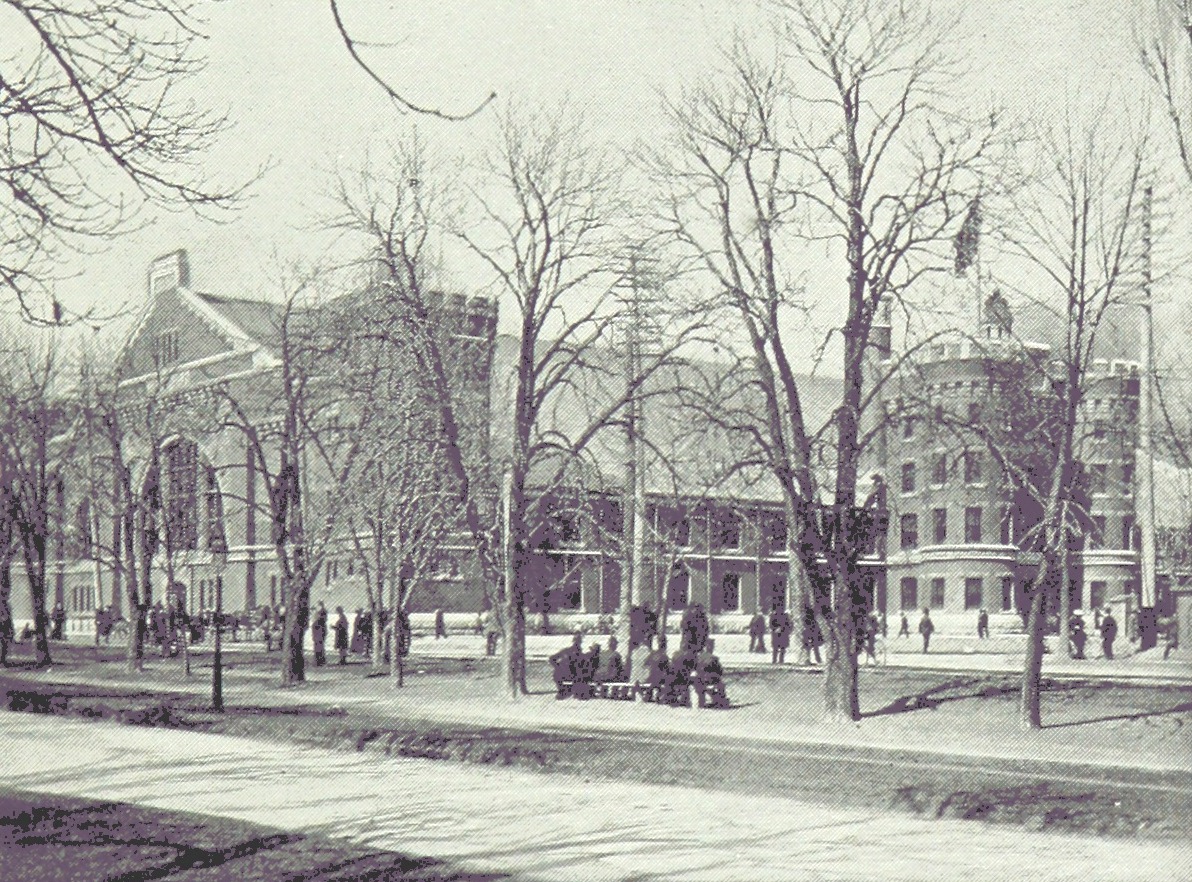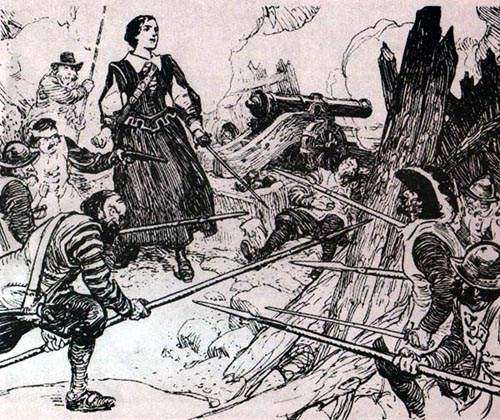|
Halifax Armoury
The Halifax Armoury is a military structure in central Halifax, Nova Scotia, Canada. The armoury is the home base of The Princess Louise Fusiliers, and several cadet units. Architecture The armoury was designed in 1895 by Chief Dominion Architect Thomas Fuller, and was opened the next year and work on the structure was completed in 1899. While the sandstone exterior is based on a medieval castle, it was actually one of the most advanced structures of its day. It was pioneering in its use of a series of Fink trusses to create a large interior space with no columns or walls, and is today the oldest surviving example of such a building. It was also one of the first buildings in Halifax to be lit by electricity. The plan is similar to that of Fuller's Toronto Armoury, completed in 1894. History It has played an important part in many Canadian wars, being an important transit point for soldiers before departing by ship for the Boer War and both World Wars. It was damaged in the Hal ... [...More Info...] [...Related Items...] OR: [Wikipedia] [Google] [Baidu] |
Halifax Common
The Halifax Common, in local popular usage often referred to as the Commons, is a Canadian urban park in Halifax, Nova Scotia. It is Canada’s oldest urban park. History The Halifax Common was originally a lightly forested swampy area which formed the source of Freshwater Brook, which flowed into Halifax Harbour near the site of today's Pier 21. The Common was designated by surveyors following the settling of Halifax in 1749. It was created to serve three purposes. The first was to provide pasturage for horses and livestock, both by the military garrison and the citizens of Halifax. The second was to create a large area in which regiments stationed and in transit through Halifax could set up camps. The third and final reason was to provide clear fields of fire for the garrison of the Halifax Citadel, so that invading forces would have no cover in the event of an assault on the fort. Originally, the Halifax Common stretched from Cunard Street, the current northern boundary of ... [...More Info...] [...Related Items...] OR: [Wikipedia] [Google] [Baidu] |
Bedford Magazine Explosion
The Bedford Magazine explosion was a conflagration resulting in a series of explosions from July 18 to 19, 1945, in Bedford, Nova Scotia, Canada. During World War II, the adjacent cities of Halifax and Dartmouth, provided heavy support for Canada's war effort in Europe. Not long after VE-Day, on the evening of Wednesday, July 18, a fire broke out on the jetty of the Bedford Magazine, now CFAD Bedford (Magazine Hill) on the Bedford Basin, north of Dartmouth. The magazine fire began when a barge exploded that evening at 6:30 PM, quickly spreading fire to the dock where ammunition had been temporarily stored outside due to overcrowding in the main compound. A chain reaction of fires, explosions and concussions ensued, continuing for more than 24 hours. Halifax, having been previously devastated by the Halifax Explosion On the morning of 6 December 1917, the French cargo ship collided with the Norwegian vessel in the waters of Halifax, Nova Scotia, Canada. The ''Mont-Bl ... [...More Info...] [...Related Items...] OR: [Wikipedia] [Google] [Baidu] |
Government Buildings Completed In 1899
A government is the system or group of people governing an organized community, generally a state. In the case of its broad associative definition, government normally consists of legislature, executive, and judiciary. Government is a means by which organizational policies are enforced, as well as a mechanism for determining policy. In many countries, the government has a kind of constitution, a statement of its governing principles and philosophy. While all types of organizations have governance, the term ''government'' is often used more specifically to refer to the approximately 200 independent national governments and subsidiary organizations. The major types of political systems in the modern era are democracies, monarchies, and authoritarian and totalitarian regimes. Historically prevalent forms of government include monarchy, aristocracy, timocracy, oligarchy, democracy, theocracy, and tyranny. These forms are not always mutually exclusive, and mixed govern ... [...More Info...] [...Related Items...] OR: [Wikipedia] [Google] [Baidu] |
Romanesque Revival Architecture In Canada
Romanesque may refer to: In art and architecture *First Romanesque, or Lombard Romanesque architectural style *Pre-Romanesque art and architecture, a term used for the early phase of the style *Romanesque architecture, architecture of Europe which emerged in the late 10th century and lasted to the 13th century **Romanesque secular and domestic architecture **Brick Romanesque, North Germany and Baltic **Norman architecture, the traditional term for the style in English **Spanish Romanesque **Romanesque architecture in France *Romanesque art, the art of Western Europe from approximately AD 1000 to the 13th century or later *Romanesque Revival architecture, an architectural style which started in the mid-19th century, inspired by the original Romanesque architecture **Richardsonian Romanesque, a style of Romanesque Revival architecture named for an American architect Other uses * ''Romanesque'' (EP), EP by Japanese rock band Buck-Tick * "Romanesque" (song), a 2007 single by J ... [...More Info...] [...Related Items...] OR: [Wikipedia] [Google] [Baidu] |
Tourist Attractions In Halifax County, Nova Scotia
Tourism is travel for pleasure or business; also the theory and practice of touring, the business of attracting, accommodating, and entertaining tourists, and the business of operating tours. The World Tourism Organization defines tourism more generally, in terms which go "beyond the common perception of tourism as being limited to holiday activity only", as people "travelling to and staying in places outside their usual environment for not more than one consecutive year for leisure and not less than 24 hours, business and other purposes". Tourism can be domestic (within the traveller's own country) or international, and international tourism has both incoming and outgoing implications on a country's balance of payments. Tourism numbers declined as a result of a strong economic slowdown (the late-2000s recession) between the second half of 2008 and the end of 2009, and in consequence of the outbreak of the 2009 H1N1 influenza virus, but slowly recovered until the COVI ... [...More Info...] [...Related Items...] OR: [Wikipedia] [Google] [Baidu] |
National Historic Sites In Nova Scotia
National may refer to: Common uses * Nation or country ** Nationality – a ''national'' is a person who is subject to a nation, regardless of whether the person has full rights as a citizen Places in the United States * National, Maryland, census-designated place * National, Nevada, ghost town * National, Utah, ghost town * National, West Virginia, unincorporated community Commerce * National (brand), a brand name of electronic goods from Panasonic * National Benzole (or simply known as National), former petrol station chain in the UK, merged with BP * National Car Rental, an American rental car company * National Energy Systems, a former name of Eco Marine Power * National Entertainment Commission, a former name of the Media Rating Council * National Motor Vehicle Company, Indianapolis, Indiana, USA 1900-1924 * National Supermarkets, a defunct American grocery store chain * National String Instrument Corporation, a guitar company formed to manufacture the first resonator gui ... [...More Info...] [...Related Items...] OR: [Wikipedia] [Google] [Baidu] |
Military History Of Nova Scotia
Nova Scotia (also known as Mi'kma'ki and Acadia) is a Canadian province located in Canada's Maritimes. The region was initially occupied by Mi'kmaq. The colonial history of Nova Scotia includes the present-day Canadian Maritime provinces and the northern part of Maine (Sunbury County, Nova Scotia), all of which were at one time part of Nova Scotia. In 1763 Cape Breton Island and St. John's Island (now Prince Edward Island) became part of Nova Scotia. In 1769, St. John's Island became a separate colony. Nova Scotia included present-day New Brunswick until that province was established in 1784. (In 1765, the county of Sunbury was created, and included the territory of present-day New Brunswick and eastern Maine as far as the Penobscot River.) During the first 150 years of European settlement, the colony was primarily made up of Catholic Acadians, Maliseet and Mi'kmaq. During the latter seventy-five years of this time period, there were six colonial wars that took place in Nova S ... [...More Info...] [...Related Items...] OR: [Wikipedia] [Google] [Baidu] |
List Of Oldest Buildings And Structures In Halifax, Nova Scotia ...
This is a list of oldest buildings and structures in Halifax, Nova Scotia, Canada that were constructed before 1935. 1750-1799 1800-1849 1850-1899 1900-1935 See also * History of Nova Scotia * List of historic places in the Halifax Regional Municipality * List of National Historic Sites of Canada in Nova Scotia * List of historic places in Nova Scotia * List of oldest buildings and structures in Toronto *History of the Halifax Regional Municipality * List of oldest buildings in Canada References {{DEFAULTSORT:Oldest buildings and structures in Halifax, Nova Scotia * Oldest buildings and structures in Halifax Halifax Buildings A building, or edifice, is an enclosed structure with a roof and walls standing more or less permanently in one place, such as a house or factory (although there's also portable buildings). Buildings come in a variety of sizes, shapes, and funct ... [...More Info...] [...Related Items...] OR: [Wikipedia] [Google] [Baidu] |
List Of Armouries In Canada
A number of armouries and drill halls exist in communities across Canada. Of these, the majority were built in Ontario and Quebec. Architecture Chief Dominion Architects The Chief Dominion Architect(s) designed a number of prominent public buildings in Canada including armouries, drill halls, post offices, and Dominion Public Buildings : Thomas Seaton Scott (1871–1881); Thomas Fuller (1881–1897); David Ewart (1897–1914); Edgar Lewis Horwood (1914–1918); Richard Cotsman Wright (1918–1927); Thomas W. Fuller (1927–1936), Charles D. Sutherland (1936–1947); Joseph Charles Gustave Brault (1947–1952) Thomas Seaton Scott, Thomas Fuller and Thomas W. Fuller adopted the ''Dominion Style'' Neo-Gothic style. David Ewart embraced the Baronial style. The armouries may display Gothic Revival (1740s+), Tudorbethan (1835–1885+), Romanesque Revival (1840–1930); Colonial Revival (1890s+); Châteauesque (1887–1930) or Edwardian Baroque 1901-1922 style. Drawings for ... [...More Info...] [...Related Items...] OR: [Wikipedia] [Google] [Baidu] |
Pugwash, Nova Scotia
Pugwash is an incorporated village in Cumberland County, Nova Scotia, Canada, located on the Northumberland Strait at the mouth of the Pugwash River. It had a population of 746 as of the 2021 census. The name Pugwash is derived from the Mi'kmaq word, Pakwesk (also written as Pagwĕsk) meaning "a shoal", in reference to a reef near the mouth of the harbour. The village is home to fishing, salt mining, and small-scale manufacturing, and tourism. Pugwash sits atop a salt deposit measuring thick and is home to the largest underground salt mine in Atlantic Canada, with shipments from its port, as well as by rail from a facility at Oxford Junction. History The end of glaciation began 13,500 years ago and ended with the region becoming largely ice-free 11,000 years ago. The earliest evidence of Palaeo-Indian settlement in the region follows rapidly after deglaciation. The Pugwash area is part of the Mi’kma’ki territory of the Mi’kmaq, who have inhabited their tradi ... [...More Info...] [...Related Items...] OR: [Wikipedia] [Google] [Baidu] |





